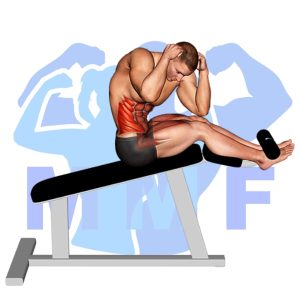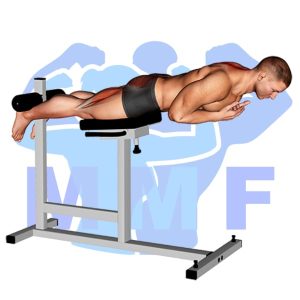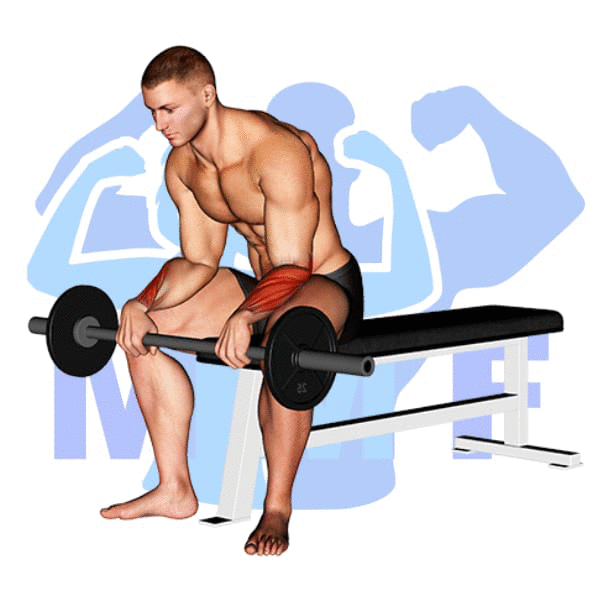Are you struggling to target your oblique muscles during your workout routine? Do hanging oblique knee raises seem intimidating and difficult to execute? You’re not alone. Many fitness enthusiasts face the same challenge. The repetitive and one-dimensional nature of traditional workouts can fail to engage and train the oblique muscles effectively. However, fear not, because there’s a simple solution to this problem. In this blog post, we will guide you on how to perform hanging oblique knee raises with ease and efficiency.
Hanging Oblique Knee Raises Summary
- Primary Muscles: Obliques
- Secondary Muscles: Adductor Brevis, Adductor Longus, Iliopsoas (Psoas Major & Iliacus), Pectineus, Rectus Abdominis, Rectus Femoris, Sartorius, and Tensor Fasciae Latae
- Equipment: Pull Up Bar
- Mechanics Type: Compound
- Force: Pull
- Utility: Basic or Auxiliary

Hanging Oblique Knee Raises Instructions
- You should begin by finding a pull-up bar where you can hang completely straight without your feet touching the ground and a safe way to reach the bar and get down.
- Once you are hanging, pull your legs up with your obliques to one side as high as possible.
- Then lower your legs back to the hanging position and repeat raising your legs to the other side.
- Continue alternating sides with your Hanging Oblique Knee Raises for 10-20 repetitions.
Video Tutorial
Hanging Oblique Knee Raises Muscles
Target (Agonist)
Synergists
- Adductor Brevis
- Adductor Longus
- Iliopsoas (Psoas Major & Iliacus)
- Pectineus
- Rectus Abdominis
- Rectus Femoris
- Sartorius
- Tensor Fasciae Latae
Dynamic Stabilizers
- Rectus Femoris
Stabilizers
Antagonist Stabilizers
- None

Benefits of Hanging Oblique Knee Raises
The hanging oblique knee raise is a great exercise for targeting the obliques, which are the muscles that run along the sides of the torso. This exercise helps to strengthen and tone the oblique muscles, resulting in improved core strength and stability, improved posture, and increased power and agility. Additionally, because this exercise is performed while hanging, it also offers a degree of instability which can help to further challenge the core and promote balance and coordination. Ultimately, performing this exercise regularly can help to improve overall athleticism and physical performance.
Tips for Performing Hanging Oblique Knee Raises
If you’re seeking to take your hanging oblique knee raises to the next level, then you’ve come to the right place. These tips will get you more from of this effective workout, and help you receive all the benefits it has to give. Concurrently with building your obliques muscles, improving movability, and also a reduced possibility of injury can all be accomplished with this exercise. So let’s begin now and see what these tips may accomplish for you.
- Engage Your Core – When performing the Hanging Oblique Knee Raises, make sure to keep your core engaged throughout the exercise. This will help to stabilize your body and provide you with more control over your movements, allowing you to get the most out of your workout.
- Keep Your Form Clean – It’s important to keep your form clean when performing the Hanging Oblique Knee Raises. This means keeping your back straight and making sure that your knees come up to hip level before lowering them back down. Doing this will ensure that you get the most out of the exercise and avoid any potential injuries.
- Use Momentum – To make the exercise easier, use momentum to help you lift your knees up and down. By rocking your body back and forth slightly, you can generate some extra momentum that will make it easier to perform the Hanging Oblique Knee Raises. Just make sure not to overdo it as it can lead to bad form.
Benefits and Tips Video
Frequent Mistakes To Avoid
When conducting hanging oblique knee raises, avoiding common errors is usually the difference between a productive workout and a painful injury. From improper form to not engaging your core, these errors can diminish the effectiveness of the exercise and can even increase your risk for injury. But don’t worry, it’s not nearly as hard as it might seem. You can perform the exercise safely and effectively by avoiding the errors to avoid and by executing the correct steps. Thus, it is now your turn to maximize your results from this exercise and enjoy the advantages of a successful workout.
- Not using proper form: Many people make the mistake of not using proper form when doing the hanging oblique knee raises, which can lead to injury or improper muscle development.
- Not engaging their core: People often forget to engage their core when doing the hanging oblique knee raises, which can lead to poor posture and an inability to properly perform the exercise.
- Not focusing on slow and controlled movements: People often rush through the exercise, performing it too quickly, which can lead to an inefficient workout and a lack of desired results.
Find More Bodyweight Exercises Here
Variations and Complementary Exercises
When performing the exercise Hanging Oblique Knee Raises, it is important to use proper form and technique to prevent injury and ensure maximum effectiveness. If you find that the exercise is too challenging or need a variation, there are several alternative exercises that work similar muscles. Below are some variations, complementary, and alternative exercises to try.
Decline Twisting Sit Up

Decline Twisting Sit Up is a great alternative or complementary exercise to Hanging Oblique Knee Raises. This exercise is performed by lying on the floor with your feet and shoulders elevated on a decline bench. From this position, you would raise your torso up, twist to one side, and then back to the center before lowering your body back down. This exercise targets the core muscles, as well as the obliques, which makes it an ideal alternative or complementary exercise to Hanging Oblique Knee Raises. Additionally, this exercise helps improve balance, coordination and agility.
Cross Oblique Crunch

The Cross Oblique Crunch is a great complementary or alternative exercise for the Hanging Oblique Knee Raises. This exercise targets the same oblique muscles as Hanging Oblique Knee Raises, but from a different angle. To perform the Cross Oblique Crunch, lie on your back with your feet flat on the floor and your hands behind your head. Then, twist your torso to the left as you bring your right knee up towards your chest, and then back down. Repeat the movement on the other side. The Cross Oblique Crunch is an excellent way to target the oblique muscles for increased strength and definition.
Cable Stability Ball Russian Twists

Cable Stability Ball Russian Twists are a great complementary or alternative exercise for Hanging Oblique Knee Raises. This exercise is performed by kneeling on the ground and holding a stability ball in both hands. From this position, twist your torso to the left and right while keeping your arms straight. The movement should originate from the waist and not the arms. This exercise helps to develop core strength, improve balance and stability, and increase abdominal muscle endurance. Additionally, it is a great way to target the oblique muscles and strengthen them.
Check Out These Top Bodyweight Exercises
Weighted Russian Twist

The Weighted Russian Twist is a great complementary or alternative exercise to the Hanging Oblique Knee Raise. This exercise works the same muscles as the hanging oblique knee raise, but in a different way. It requires you to sit on the floor with your knees bent and feet flat on the ground. You then hold a weight close to your chest and twist your torso from side to side, engaging your core and obliques. This exercise is great for developing strength and stability in the core and obliques, as well as improving posture.
Side Crunches

Side crunches are an excellent complementary exercise for hanging oblique knee raises. Side crunches are a core-strengthening exercise that strengthens the muscles on the sides of your abdomen. They work the obliques and rectus abdominis, which are both important muscles for maintaining good posture and balance. When performed in conjunction with hanging oblique knee raises, side crunches help to ensure that your core is being worked from all angles and in a balanced manner. Additionally, side crunches also help to develop balance, coordination and agility, further enhancing the benefits of the hanging oblique knee raise exercise.
Side Bridge Hip Abductor

The Side Bridge Hip Abductor is a great complementary or alternative exercise to the Hanging Oblique Knee Raises. This exercise strengthens your core and hip muscles while also improving balance and coordination. It is a unilateral exercise that works your glutes and abductors on one side at a time. To do this exercise, start in a side plank position and then lift your top leg up and out to the side, keeping your body in a straight line. Hold for a few seconds, then return to the starting position. This exercise helps improve your stability and can be used as an alternative or complementary exercise to the Hanging Oblique Knee Raises.
Find More Abs Exercises Here
Opposing Complementary Exercises
To further complement the exercise Hanging Oblique Knee Raises, here are a few exercises to help work the opposing muscle groups. These exercises will help to strengthen and balance the muscles you used during the Hanging Oblique Knee Raises, as well as add variety to your routine.
45 Degree Hyperextensions

45 Degree Hyperextensions are a great complement to the exercise Hanging Oblique Knee Raises as they target the opposing muscle group. Hanging Oblique Knee Raises target the obliques, while 45 Degree Hyperextensions target the lower back. This combination of exercises allows for a full core workout, strengthening both the oblique and lower back muscles. Furthermore, 45 Degree Hyperextensions can help to prevent injury and build stability in the spine by engaging the lumbar muscles. This is beneficial when performing Hanging Oblique Knee Raises as it allows for increased range of motion without risk of injury.
Hyperextension

Hyperextension is a great complementary exercise to Hanging Oblique Knee Raises. Hyperextension works the opposing muscle group, the lower back and glutes, by stretching and contracting them to help strengthen and stabilize the body. This helps create balance in the body and prevents injury. Furthermore, it helps to improve posture and can help to alleviate back pain. By doing Hyperextension alongside Hanging Oblique Knee Raises, you are able to work both muscle groups and create balance in your body.
Bench Hyperextension

Bench Hyperextension is a great complementary exercise to Hanging Oblique Knee Raises as it targets the opposing muscle group. By performing Bench Hyperextensions, the lower back and glute muscles are engaged and strengthened, while the obliques and abdominals used in Hanging Oblique Knee Raises are stretched. Furthermore, the range of motion and intensity of the Bench Hyperextension can be adjusted to further increase the effectiveness of the exercise. As such, performing Bench Hyperextensions in conjunction with Hanging Oblique Knee Raises will help to ensure that both sets of muscles are optimally worked and balanced.
Unleash Your Core Strength with Hanging Oblique Knee Raises
If you’re looking for a way to challenge your core, then hanging oblique knee raises are a great choice. By working your obliques, you can not only create a more defined waistline, but also improve your overall strength and stability. These exercises involve lifting your knees to the side while hanging from a bar, which requires a significant amount of upper body strength in addition to your core. However, with practice and dedication, you can increase your ability to perform hanging oblique knee raises and unleash your full core strength.
References: Wikipedia | ExRx.net | PubMed.gov | Comprehensive List of Abs Bodyweight Exercises




